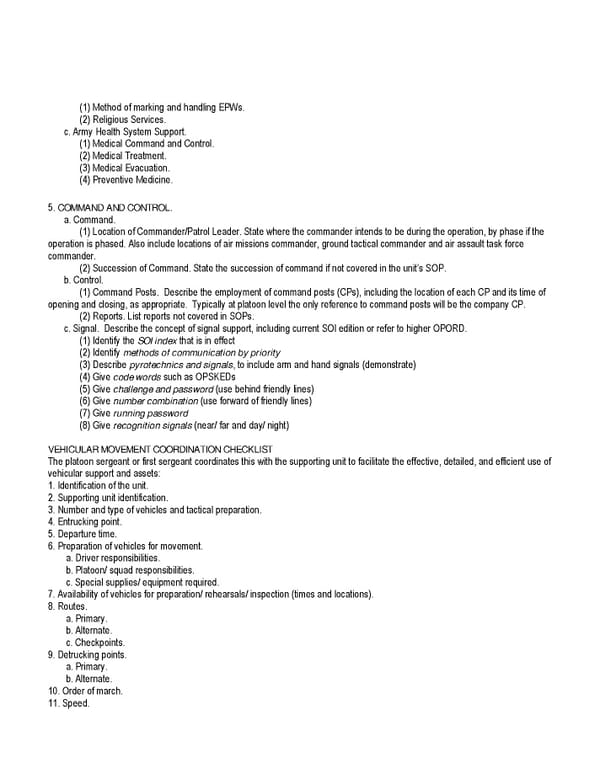(1) Method of marking and handling EPWs. (2) Religious Services. c. Army Health System Support. (1) Medical Command and Control. (2) Medical Treatment. (3) Medical Evacuation. (4) Preventive Medicine. 5. COMMAND AND CONTROL. a. Command. (1) Location of Commander/Patrol Leader. State where the commander intends to be during the operation, by phase if the operation is phased. Also include locations of air missions commander, ground tactical commander and air assault task force commander. (2) Succession of Command. State the succession of command if not covered in the unit’s SOP. b. Control. (1) Command Posts. Describe the employment of command posts (CPs), including the location of each CP and its time of opening and closing, as appropriate. Typically at platoon level the only reference to command posts will be the company CP. (2) Reports. List reports not covered in SOPs. c. Signal. Describe the concept of signal support, including current SOI edition or refer to higher OPORD. (1) Identify the SOI index that is in effect (2) Identify methods of communication by priority (3) Describe pyrotechnics and signals, to include arm and hand signals (demonstrate) (4) Give code words such as OPSKEDs (5) Give challenge and password (use behind friendly lines) (6) Give number combination (use forward of friendly lines) (7) Give running password (8) Give recognition signals (near/ far and day/ night) VEHICULAR MOVEMENT COORDINATION CHECKLIST The platoon sergeant or first sergeant coordinates this with the supporting unit to facilitate the effective, detailed, and efficient use of vehicular support and assets: 1. Identification of the unit. 2. Supporting unit identification. 3. Number and type of vehicles and tactical preparation. 4. Entrucking point. 5. Departure time. 6. Preparation of vehicles for movement. a. Driver responsibilities. b. Platoon/ squad responsibilities. c. Special supplies/ equipment required. 7. Availability of vehicles for preparation/ rehearsals/ inspection (times and locations). 8. Routes. a. Primary. b. Alternate. c. Checkpoints. 9. Detrucking points. a. Primary. b. Alternate. 10. Order of march. 11. Speed.
 Ranger Handbook Page 49 Page 51
Ranger Handbook Page 49 Page 51